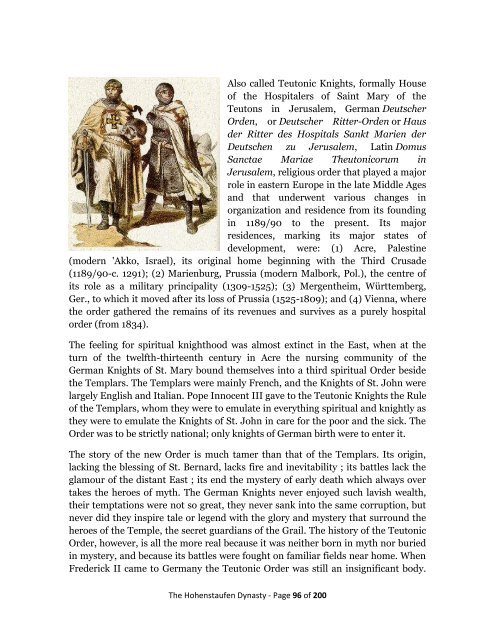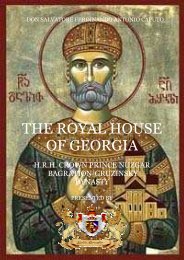here - Nobility Associations
here - Nobility Associations
here - Nobility Associations
Create successful ePaper yourself
Turn your PDF publications into a flip-book with our unique Google optimized e-Paper software.
Also called Teutonic Knights, formally House<br />
of the Hospitalers of Saint Mary of the<br />
Teutons in Jerusalem, German Deutscher<br />
Orden, or Deutscher Ritter-Orden or Haus<br />
der Ritter des Hospitals Sankt Marien der<br />
Deutschen zu Jerusalem, Latin Domus<br />
Sanctae Mariae Theutonicorum in<br />
Jerusalem, religious order that played a major<br />
role in eastern Europe in the late Middle Ages<br />
and that underwent various changes in<br />
organization and residence from its founding<br />
in 1189/90 to the present. Its major<br />
residences, marking its major states of<br />
development, were: (1) Acre, Palestine<br />
(modern 'Akko, Israel), its original home beginning with the Third Crusade<br />
(1189/90-c. 1291); (2) Marienburg, Prussia (modern Malbork, Pol.), the centre of<br />
its role as a military principality (1309-1525); (3) Mergentheim, Württemberg,<br />
Ger., to which it moved after its loss of Prussia (1525-1809); and (4) Vienna, w<strong>here</strong><br />
the order gat<strong>here</strong>d the remains of its revenues and survives as a purely hospital<br />
order (from 1834).<br />
The feeling for spiritual knighthood was almost extinct in the East, when at the<br />
turn of the twelfth-thirteenth century in Acre the nursing community of the<br />
German Knights of St. Mary bound themselves into a third spiritual Order beside<br />
the Templars. The Templars were mainly French, and the Knights of St. John were<br />
largely English and Italian. Pope Innocent III gave to the Teutonic Knights the Rule<br />
of the Templars, whom they were to emulate in everything spiritual and knightly as<br />
they were to emulate the Knights of St. John in care for the poor and the sick. The<br />
Order was to be strictly national; only knights of German birth were to enter it.<br />
The story of the new Order is much tamer than that of the Templars. Its origin,<br />
lacking the blessing of St. Bernard, lacks fire and inevitability ; its battles lack the<br />
glamour of the distant East ; its end the mystery of early death which always over<br />
takes the heroes of myth. The German Knights never enjoyed such lavish wealth,<br />
their temptations were not so great, they never sank into the same corruption, but<br />
never did they inspire tale or legend with the glory and mystery that surround the<br />
heroes of the Temple, the secret guardians of the Grail. The history of the Teutonic<br />
Order, however, is all the more real because it was neither born in myth nor buried<br />
in mystery, and because its battles were fought on familiar fields near home. When<br />
Frederick II came to Germany the Teutonic Order was still an insignificant body.<br />
The Hohenstaufen Dynasty - Page 96 of 200



